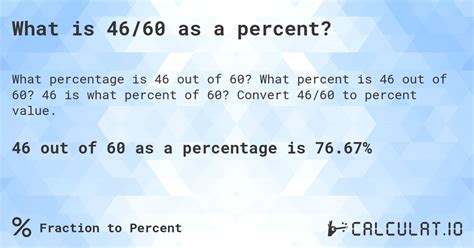46 Out Of 60 As A Percentage
Kalali
Apr 04, 2025 · 4 min read

Table of Contents
46 out of 60 as a Percentage: A Comprehensive Guide
Calculating percentages is a fundamental skill with widespread applications in various fields, from academic assessments to financial analysis and everyday life. Understanding how to convert fractions to percentages is crucial for interpreting data, making informed decisions, and communicating effectively. This article will delve into the calculation of 46 out of 60 as a percentage, providing a step-by-step guide, exploring different calculation methods, and highlighting real-world applications. We'll also touch upon the importance of understanding percentages in various contexts and how to use this skill to your advantage.
Understanding Percentages
Before we delve into the specifics of calculating 46 out of 60 as a percentage, let's solidify our understanding of percentages themselves. A percentage is a fraction or ratio expressed as a number out of 100. The symbol "%" signifies "percent" or "out of 100." For instance, 50% means 50 out of 100, which simplifies to 1/2 or 0.5.
Percentages are incredibly versatile because they allow for easy comparison of proportions. Whether you're comparing test scores, market shares, or discount rates, percentages provide a standardized way to express relative values.
Calculating 46 out of 60 as a Percentage: The Simple Method
The most straightforward method for calculating 46 out of 60 as a percentage involves these three steps:
Step 1: Formulate the Fraction
First, express the given numbers as a fraction. In this case, 46 out of 60 is written as 46/60.
Step 2: Convert the Fraction to a Decimal
Divide the numerator (46) by the denominator (60):
46 ÷ 60 = 0.766666...
Step 3: Convert the Decimal to a Percentage
Multiply the decimal by 100 and add the "%" symbol:
0.766666... × 100 = 76.67% (rounded to two decimal places)
Therefore, 46 out of 60 is 76.67%.
Alternative Calculation Methods
While the method above is the most common and readily understandable, there are alternative approaches you can use to arrive at the same result:
Using Proportions
You can solve this problem using proportions. Set up a proportion where x represents the percentage:
46/60 = x/100
To solve for x, cross-multiply:
60x = 4600
x = 4600/60
x = 76.67%
Using a Calculator with Percentage Function
Most calculators have a percentage function (%) that simplifies the process. Simply enter 46 ÷ 60 and then press the percentage button. The calculator will automatically perform the multiplication by 100 and display the result as a percentage.
Real-World Applications of Percentage Calculations
The ability to calculate percentages accurately is essential in many real-world scenarios:
Academic Performance
Students frequently encounter percentage calculations when determining their grades. If a student scores 46 out of 60 on a test, knowing that it represents 76.67% helps them understand their performance relative to the total possible score.
Financial Matters
Percentages are ubiquitous in finance. Calculating interest rates, discounts, taxes, and profit margins all involve percentage calculations. Understanding these calculations is vital for making informed financial decisions. For example, if a store offers a 20% discount on an item, calculating the final price requires percentage skills.
Data Analysis and Statistics
In data analysis and statistics, percentages are used to represent proportions and trends within datasets. For example, if a survey reveals that 46 out of 60 respondents prefer a particular product, this can be expressed as 76.67% preference.
Business and Marketing
Businesses use percentages extensively for tracking sales figures, market share, and customer satisfaction. Analyzing these metrics helps companies make data-driven decisions to improve their operations and increase profitability.
Everyday Life
Even in our daily lives, we encounter percentage calculations regularly. For example, calculating tips at restaurants, determining the sale price of an item, or understanding nutritional information on food labels all involve percentages.
Importance of Accuracy in Percentage Calculations
Accuracy is paramount when working with percentages. Even small errors can have significant implications, particularly in financial or scientific contexts. Always double-check your calculations and use appropriate rounding techniques to ensure accuracy.
Improving Your Percentage Calculation Skills
Consistent practice is key to improving your proficiency in percentage calculations. Work through various problems, using different methods to build your understanding and confidence. You can also find many online resources and practice exercises to help you hone your skills.
Conclusion: Mastering Percentages for Success
The ability to calculate percentages effectively is a valuable asset in many aspects of life. Understanding how to convert fractions and decimals to percentages, along with applying this knowledge to real-world scenarios, empowers you to make informed decisions, analyze data accurately, and communicate information clearly. The simple calculation of 46 out of 60 as 76.67% serves as a foundational example of this crucial skill. By mastering percentage calculations, you equip yourself with a valuable tool for academic, professional, and personal success. Remember to practice regularly and utilize various methods to solidify your understanding and build confidence in your abilities. This will not only improve your problem-solving skills but also enhance your overall comprehension of quantitative information presented in various formats.
Latest Posts
Latest Posts
-
1 7 Oz Is How Many Milliliters
Apr 04, 2025
-
How Many Inches Is 16 Centimeters
Apr 04, 2025
-
How Many Cm Is 16 5 Inches
Apr 04, 2025
-
What Percentage Is 2 Out Of 6
Apr 04, 2025
-
25 Cm Is What In Inches
Apr 04, 2025
Related Post
Thank you for visiting our website which covers about 46 Out Of 60 As A Percentage . We hope the information provided has been useful to you. Feel free to contact us if you have any questions or need further assistance. See you next time and don't miss to bookmark.
